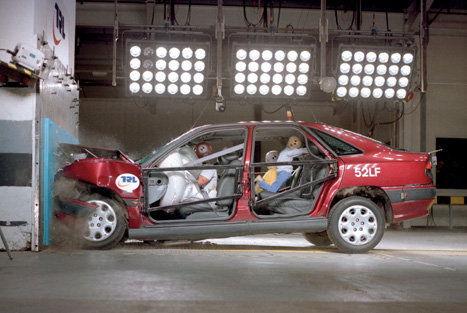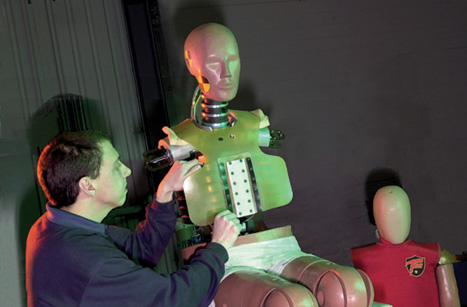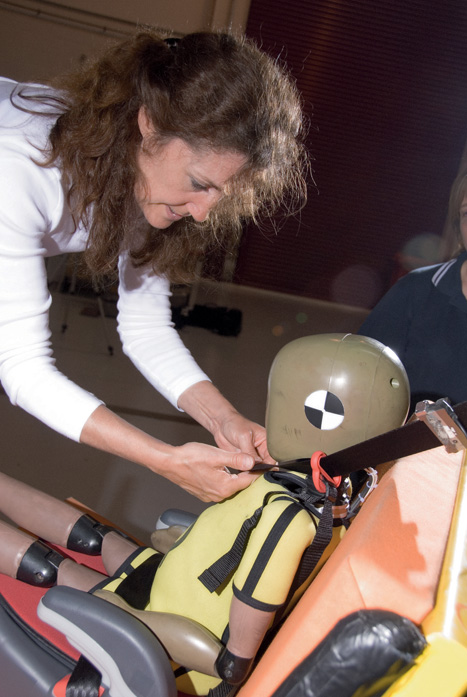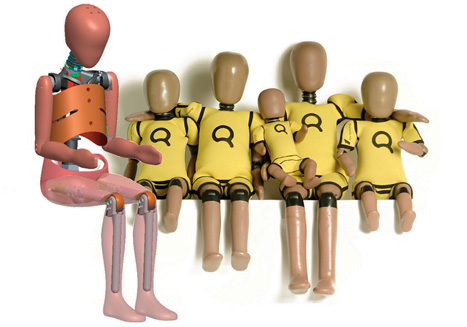Here’s a name that deserves to be better known: Colonel John Stapp. A US Air Force officer, Stapp was instrumental in research on the effects of sudden deceleration, taking rides on a 400mph-plus rocket sled that was decelerated rapidly with a hydraulic braking system all to find ways of improving seat harnesses for air-force pilots. Stapp was one of the most frequent volunteers for the sled tests, subjecting himself to deceleration forces up to 46g and suffering broken ribs, arms,legs and permanently burst blood vessels in his eyes. With this experience, it’s hardly surprising that Stapp was also a leader in the development of crash-test dummies.
’Although Stapp was working on preventing injuries in aircraft crashes, he noticed during his research that just as many, if not more, airmen were injured when the jeeps taking them to their aircraft crashed,’ explained Dr David Hynd, head of the biomechanics and injury-prevention group at the Transport Research Laboratory, the Bracknell-based organisation that is one of the main centres for crash testing in the UK. ’So he started looking at restraints in cars and became an early advocate of seat belts to prevent injury back then they were lap belts.’ Among Stapp’s methods was staging demonstrations of crashes with and without belts: the first known use of crash-test dummies for car safety.

Previously, Hynd explained, dummies had been used to develop and test ejector seats. ’The dummies were pretty basic and so were the tests,’ he said. ’They were mostly there to make sure that, as the seat was ejected from the aircraft, the pilot wouldn’t be hurt. If the dummy came down without lower legs, then there wasn’t enough clearance between the seat and the instrument panel. It was that basic.’
As the tests developed and sensors were introduced, the dummies became more of a research tool. ’There were simple accelerometers in the spine to determine the compression forces that the pilot would be subjected to as the rocket in the base of the seat fired,’ Hynd said. ’It was still pretty basic, but that’s the genesis of the sort of dummies we use today.’
TRL is also the centre for crash-test dummy development in the UK. David and Marianne Hynd lead the dummy-development team possibly one of the oddest husband-and-wife teams in the UK.
Interviewing the Hynds is a somewhat surreal experience. The conference rooms at TRL are small, comfortable and well equipped, and all named after types of pedestrian crossing. The Pelican room is quite crowded: two researchers, one journalist and a ’Goldilocks’ selection of dummies daddy dummy, mummy dummy and baby dummy lined up and watching impassively along one wall. Enigmatic Mona Lisa smiles on their moulded faces, the dummies are an unsettling presence strapped onto trollies, with articulated necks, exposed metal ribcages, sheaves of cables spilling from their spines and incongruous sensible black leather shoes. ’The shoes are specified by the regulations,’ David said with a smile as inscrutable as the dummies’.

Today’s dummies are much more advanced than their forebears from half a century ago. ’We have to make sure that they mimic as far as possible the human body in material and biomechanical terms,’ David said. ’That means that the distribution of weight in the different parts of the body has to match the range of movement in the limbs; and we have to match the resilience of different types of tissue. We also, to a certain extent, try to copy the way that a person responds in a crash, which is down to the effect of muscle tone.’
The way this is done depends on two different types of tests. One uses donated cadavers a form of testing used since the earliest days of crash testing. The other, also with a long history, uses volunteers, although the way the information is gathered from these tests has changed considerably. ’We can get information about weight distribution, proportions and suchlike from cadavers, but they have no muscle tone, of course,’ David said. ’So we need to use volunteers, but we don’t go anything like as far as Colonel Stapp did.’
“Volunteers don’t have any warning of the crash – we might blindfold them and play music through headphonesso they can’t get any clues”
David Hynd, TRL
A typical volunteer trial for, for example, a collision from the rear would involve recreating the conditions of a crash at no more than about 9km/h. ’That’s enough to give you a jolt, definitely, but not fast enough to hurt you or give you whiplash,’ David said. The volunteer would typically be arrayed with a large number of sensors accelerometers to determine how far and how fast body parts move; load cells to measure the pressure exerted by parts of the body in contact with any surface, such as the seat back, cushion, headrest or safety belt; and myoelectric sensors to detect nerve signals in various muscles, determining how much, and at what point, they tense up. Sensors are also placed in the seat and on the belt reel and fixing points. The test subjects can also be fitted with motion-capture points on the head, shoulders, arms and legs so that a computer model of their movement during the crash can be constructed.
’We try to make it as realistic for the volunteer as we can within the conditions of the simulation,’ David said. ’For example, people generally don’t have any warning of the crash, so we might blindfold them and play music through headphones so that they can’t get any visual or sound cues about when we’re going to do the actual test. And we do different sorts of crash because we make different types of dummy there are dummies for frontal crashes and side crashes, and dummies for use in car-crash and train-crash simulations. We also need a range of volunteers, because we make different sizes of dummies average size and 90th percentile male and female, pregnant dummies and so on. We need the full range of information.’
The information gained during these trials can be used to construct a dummy that is then fitted with sensors in locations appropriate to the type of crash being simulated. ’For a frontal collision, important information includes chest compression, the force imparted by an inflating air bag, the forces from the seat back and so on,’ David said. ’But for a train-crash simulation, you’d want to look at the effect of impacting the seat in front, or what happens when a table edge goes into the abdomen. We need to look at all those types of loading.’

The situation is the same for building a child dummy as much information as possible. But Marianne, who specialises in designing child dummies, explained that the information is much harder to come by.
’You can’t do volunteer tests with children and of course cadaver tests are completely impossible as well,’ she said. ’The only way we can get the biomechanical information about how children’s bodies react during crash situations is from real-life crashes and we study those by recreating them in as much detail as possible.’
The painstaking process of accident recreation generally begins with a desperately sad set of data an injury report from a hospital, or coroner’s report, on a child injured in a car crash. ’It’s vital that it’s a particular type of accident,’ Marianne said. ’It has to be a relatively simple collision between no more than two cars and we have to look for crashes that fit into the categories we have to test frontal collision, side collision, rear collision.’
These reports would be studied in detail in conjunction with the police report on the accident and on the vehicle or vehicles involved. ’What we’re looking for here is to find out, as precisely as possible, what caused the injuries and for that we need to know where the child was in the car, how fast the cars involved in the incident were travelling and in what relative directions; the make and models of the cars involved, how the child was restrained and so on,’ Marianne said.
Not all of this information is readily available. ’Sometimes we don’t know anything about the child seat or booster that was used,’ Marianne said. ’More usually, we do know what make and model it was, but the ambulance services and fire brigade generally take the seat out of the vehicle and there’s often no information about how it was fixed in. That’s quite a big problem, because it’s not uncommon that incorrect fixing is a major factor in the injuries. In those situations, we have to make the best guesses we can.’
The released pendulum swung into the dummy’s chest and it collapsed backwards with a resounding crash
Once the data have been mined, the team sets up the accident reconstruction itself and again, verisimilitude is the key. ’We buy the exact same make and model of both cars involved and we set them up exactly as they were in the collision,’ Marianne said. The team uses a cable system to propel the cars into the crash itself, with a test dummy standing in for the child.
Once the crash has been performed, the team then studies the cars and compares the resulting damage to the cars involved in the real crash. If they match, then the reconstruction is deemed a success and the results, showing the forces acting on the dummy, can be used. It’s a case of working backwards to match the real injuries to the forces derived from the reconstruction, Marianne explained.

This is a major undertaking. ’A reconstruction will normally take about six months to put together and it’s generally a collaboration between us and the various safety organisations in Europe,’ she said. ’And even then, results aren’t guaranteed.’
Only about half of reconstructions are deemed successful, she explained. And even a successful exercise produces only one data point that can be used to create an accurate dummy. ’Ideally, you’d want as many data points as possible 100 or more, if you could manage it,’ she said. ’We have to make do with far fewer, because reconstructions are just so difficult, expensive and time-consuming.’
Results of the tests are used for all aspects of design, from car cabins to child seats. ’We develop the protocols for testing child seats and their attachments, which is a long-term project,’ Marianne said.
The tests and, indeed, the dummies can be surprisingly harrowing. Marianne admits that she finds it difficult to handle the ’newborn’-sized child dummy because it feels so similar to a real baby, and that she finds some of the tests hard to watch. I had a taste of this myself, when David and Marianne set up a ’pendulum test’ a basic test to see what happens when a crash sends an object into a person’s chest using a dummy that mimics a four-year-old child.
David arranged the dummy seated on a trolley and centred the pendulum a steel cylinder suspended from a gantry by eight adjustable cables on its chest, then winched it back to attach it to an electromagnet. After connecting the dummy’s sensor cables to a datalogger the latest dummies have internal dataloggers, which remove the need for thick bundles of cables, he explained he set up a 1,000 frame/sec camera, used to provide slow-motion images of the tests.
The released pendulum swung into the dummy’s chest and it collapsed backwards onto the trolley with a resounding crash, its head rebounding and bouncing back twice. It was hard not to wince, even more so when the slow-motion film was played back. Marianne pointed out the way the chest compressed; the movement of the shoulders forward and in and the forward jolt of the head before the momentum of the pendulum propelled the dummy’s upper body backwards. ’That’s a good test,’ David concluded.
Dummy development is used nowadays alongside finite-element analysis, which is used to develop car interiors and the restraints, airbags and protective structures that protect the driver. ’One feeds into the other,’ David said. ’But although there have been suggestions that computer simulation could replace crash testing, so far we’ve not found any substitute for doing these tests for real.’
Case Study - model family
Toyota’s digital THUMS dummies aim to determine what happens to the body when it is subjected to a crash
Among the digital crash-test dummies developed by car companies to assist in their safety development is Toyota’s Total Human Model for Safety (THUMS) family. Used in conjunction with crash tests, of which the company claims to perform more than 1,000 each year, the THUMS system aims to analyse the damage caused in crashes to a level not possible with dummies alone.
THUMS works by modelling the internal structures of the human body bones, ligaments and tendons to determine, in detail, what happens to a body subjected to the stress of a crash. This modelling extends to all parts of the body and, in its latest version, even takes in the internal organs, with the brain, heart, lungs and liver all modelled using data from CT scans. ’By creating precise models of various internal organs, including their position and how they interconnect, Toyota was able to develop a virtual human model containing approximately 14 times more information than the previous version,’ the company claims.
THUMS was first developed in 1997, with a basic FEM model of the human body. Bones and a face were added in 2004, and a brain model followed in 2006. The latest iteration allows damage such as liver distortion and heart bruising. The models are used to model both drivers andpedestrians.




Red Bull makes hydrogen fuel cell play with AVL
Many a true word spoken in jest. "<i><b>Surely EVs are the best solution for motor sports</b></i>?" Naturally, two electric motors demonstrably...